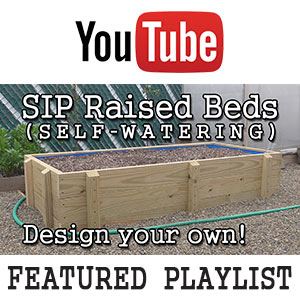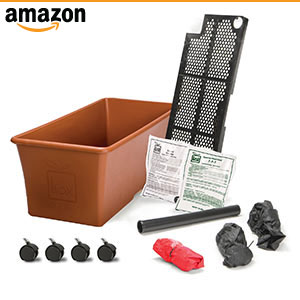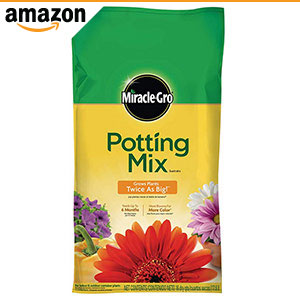Minimize Over-fertilizing in SIPs
In all methods of gardening, over-fertilization is a valid concern. Regardless of synthetic or organic, whether it's compost or fertilizer, we should be aware of the potential to overfeed our plants. Excessive levels of some nutrients could create a "lock-out", preventing other nutrients from being absorbed by plants. Or nutrient runoff could occur as rainfall washes away dissolved salts. Even from a simple financial standpoint, there's no point in wasting money due to over application of a fertilizer.
Nutrient Management
SOIL TESTS: Annual soil tests are ideal, allowing a gardener to know if nutrient levels are starting to exceed recommended concentrations. Of course, soil tests might not be practical if you have many small planting sites scattered all over your property. What if you have 8 SIP totes? Should each one be tested? Perhaps each spot could be tested every few years. Or you might be able to self-test your mixes by checking the EC. Regardless, it's good to learn additional strategies.
CROP ROTATION: Do you have multiple planters and plant types that you like to grow each year? Alternating which plants are grown in each spot can alter the profile of nutrients that are left behind in the soil so that there is less buildup over time. As an added bonus, disease suppression is improved as well. Switching out key crops might not always be practical though, especially if you don't grow many crop types.
SCAVENGER CROPS: This is my preferred strategy for reducing nutrient levels and preparing my potting mix for Spring fertilization. This is a crop rotation of sorts, even though I always grow my key crops in the same physical locations each year. However, once they are harvested, I plant a second crop that is a heavy nutrient feeder. This crop is not fertilized. It merely draws upon any remaining nutrients that were added in the Spring.
Brassicas are well known as heavy feeding plants. These also are great candidates for Fall crops. So after my onions, garlic, squash, zukes, melons and corn are harvested, I drop in kale, broccoli and other brassicas. You can start them ahead as seedlings to maximize your harvest. Or simply drop in seeds. Kale is a biennial which has survived over the Winter in my SIPs in zone 6. In the Spring it resumes growth drawing up even more nutrients before blooming and producing seed.
Nutrient Run-Off
One of the biggest drawbacks of excess nutrients is the run-off that results and often enters our waterways. As fertilizer salts make their way into streams and rivers this can have a very damaging effect on the ecosystem. How do SIPs factor into the equation?
Leaching of Salts
A SLOW BUILD-UP: Household plants are notorious for salt build-up unless they are thoroughly flushed from time to time. Since SIPs do not completely drain out, there's the potential for salt build up in them too. A salt can mean more than just sodium chloride. Other minerals exist in salt form too such as calcium, magnesium or potassium. However, plants use these in larger quantities. Thus toxic build up of sodium or chlorides can occur more easily over time since vegetables won't be absorbing much in into their tissues.
AVOIDING HIGH SALTS: This might result form minerals in irrigation water or nutrients from fertilizers. Potassium chloride might be used as a potassium fertilizer. While the plants need large quantities of potassium (a macro-nutrient) they don't need nearly as much of the chloride, which remains underutilized. This problem doesn't just come from synthetic fertilizers. Animal manures, especially dairy and poultry can have high salt levels. Even composts can contribute to chloride build-up, particularly if the compost is a by-product of the manufacturing industry. Just another reason to avoid bagged composts and manures!
FLUSHING SALTS: What can you do to reduce salt build-up? One way option is to leave the SIPs uncovered during a wet Winter period. The precipitation effectively leaches away salts and nutrients. This option is not perfect though. If the overflow tube of the SIP freezes up, the entire thing could turn into a huge block of ice. A secondary option is to manually flush salts through excessive irrigation. This could be done in the Fall after crops have been harvested or in Spring before fertilizing. Water the soil surface with a long steady drench using your regular sprinkle setting. This will flush salts down through the soil. Then pump lots of water down into the reservoir, continuing to fill it even after it starts overflowing.
Obviously, this technique can waste quite a bit of water. And of course, those salts all flow out onto the ground. But if you get a soil test showing that sodium or chloride levels are excessive, this is the way to remediate the issue. I've never personally needed to do so. But the quality of your irrigation water and your precipitation rates will be a big factor. In coastal regions, even rainfall can be a source of salts. So be mindful of local environmental factors and how they may affect your SIP.
Reducing Run-Off From SIPs
SIPs vs DRAIN HOLE CONTAINERS: Sub-irrigated planters can result in much less nutrient runoff since excess water is captured in the reservoir. Compared to traditional containers, this is a significant advantage. The reservoir can act as a buffer absorbing part or perhaps all of the rain that falls on it. Even once the soil is at full saturation, the reservoir will still hold 3 inches of water.
REDUCING OVERFLOW: For it to work well though, I find it best to avoid frequent topping off my SIPs especially in the Spring when it's rainy and plants are still small. This allows the reservoir to absorb more rain water before maxing out and overflowing. When I do decide to add water, I avoid watering to the point that it overflows out of the overflow tube. A little water every day works well.
NUTRIENT USAGE: Using organic fertilizers rather than synthetics may reduce the amount nutrients in the runoff water. That's because organics tend to be less water soluble. For example, Espoma claims that their Garden-Tone fertilizer is "Long-lasting, slow release. Won’t burn or leach away." When applying fertilizers I prefer to mix the nutrients into the top 6 inches of potting mix. The same goes for the depth of my fertilizer bands. Thus the unfertilized layer of soil underneath can help to lock away nutrients as they dissolve.
HARVESTING RUN-OFF: In the late Spring I tested the run-off water coming out of my new SIP raised bed. My tap water had an EC of 240 but the run-off water was 630. That is comparable to a half strength hydroponic solution. Clearly, nutrients were being lost. But where do they go? If the water runs directly into a storm drain then that's a huge problem. But if that small amount of run-off is directed to a secondary planting bed, then it's not so bad. Why not consider this when you plan your garden layout? I have a mid sized SIP bed that overflows into a strawberry patch. Behind that, there are 3 plum trees. These plants can easily soak up any lost nutrients, keeping my storm water filtered and clean!
← Fertilizer Application Rates: Containers
Start Small. Build an Albo-stein →



![Long Live PERENNIALS! [Gardening T-Shirt Design] Long Live PERENNIALS! [Gardening T-Shirt Design]](images/Long-Live-PERENNIALS-Gardening-T-Shirt-th.jpg)


